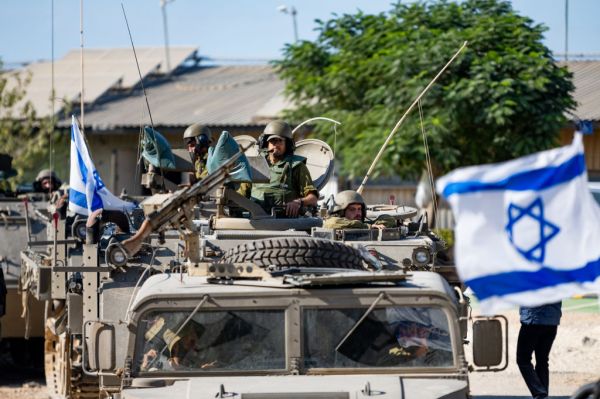KEREM SHALOM, Israel—Semitrucks piled high with food and other supplies passed through this southern crossing and into the Gaza Strip by the dozens under the midday sun. Hours later, according to a preliminary Israel Defense Forces (IDF) assessment, Palestinian gunmen opened fire on and killed several civilians lining up by a 31-truck aid convoy that had reached Gaza City.
Israeli officials fear the Thursday incident, in which they say no IDF shots were fired, may be part of a Hamas campaign to exacerbate and weaponize Gaza’s worsening humanitarian situation. Widespread looting and lawlessness have already forced some aid groups to suspend operations in the enclave, as Israel struggles to secure safe passage for private contractors to reach civilians in need. Meanwhile, the U.S., Israel, and other regional partners have begun to flood the Strip with aid—from the land, sea, and air—in an effort to bypass the distribution issues inside Gaza.
“I want to emphasize a critical point,” Col. Elad Goren, the civil affairs head of COGAT, the Israeli agency tasked with facilitating humanitarian aid shipments into Gaza, said from the Kerem Shalom checkpoint that day. “Israel is doing everything, and I mean everything, it can to mitigate the humanitarian consequences of Hamas’ actions in the Gaza Strip.”
The Geneva Convention, of which Israel is a signatory, requires warring states to allow for the “free passage” of food and other humanitarian assistance. Israel insists it has done just that.
Before the war, an average of 70 trucks carrying food arrived in Gaza every day, Israeli officials said. As the wartime need has grown, so too have Israel’s efforts to inspect and facilitate aid shipments in an expedited manner. Since the beginning of March, an average of 126 trucks per day have entered the Strip. More than 16,000 trucks—some 9,500 of them carrying more than 200,000 tons of food—have crossed into wartime Gaza in all, according to COGAT.
All trucks entering Gaza undergo Israeli inspections to prevent items that can be used for military purposes from reaching Hamas, though some dual-use material can enter the Strip if it has a clear humanitarian purpose. Of the international aid that reaches the inspection sites, 99 percent passes into the enclave unhindered, according to COGAT.
“What Israel is prioritizing right now in terms of the aid making its way is food, water, medical supplies, and shelter equipment,” Shimon Freedman, a spokesman for COGAT, told The Dispatch. “The security inspections are necessary to prevent things from getting to Hamas, but it’s not standing in the way of aid making its way to the people in Gaza who need it.”
But Israel says the challenge isn’t in the volume of aid going into Gaza but in its distribution to civilians in the combat zone—a role traditionally left to humanitarian organizations like the U.N. World Food Program (WFP), which last month halted its operations in Gaza, citing the dangers posed by the “collapse of civil order” within the Strip. Gazans are now increasingly reliant on private contractors for incoming supplies. The U.N. delivered less than 10 percent of aid shipments to northern Gaza this month, compared to 25 percent last month, even as the U.N. children’s agency said Friday that nearly one-third of children under 2 in northern Gaza have acute malnutrition.
This reduced U.N. involvement has led to bottlenecks on the Gazan side of the border, where rows of white pallets containing tons of humanitarian aid waiting to be collected and delivered were visible from the Israel-run checkpoint on Thursday.
“This is not a rare scene. Often, there are hundreds of trucks worth of aid waiting on the Gazan side to be picked up. That is the biggest obstacle to aid reaching Gazans in need,” Goren said. “The international organizations do not have the capacity, and have yet to take real steps to improve that capacity, to distribute the humanitarian aid through the Gaza Strip—including the north. … If the U.N. wants to see more aid reach northern Gaza, they need to coordinate more convoys—as simple as that.”
Israel recently opened a new border crossing near Be’eri—one of the Israeli communities most devastated by the October 7 attack by Hamas that left nearly 1,200 dead—in the hopes that aid convoys can circumvent areas with a significant Hamas presence. On Tuesday, six trucks carrying food for 25,000 people used the route as part of what COGAT called “an experimental pilot in order to prevent Hamas from taking over the aid.”
The supplies-laden convoys typically need to drive through the southern part of the Strip to reach the north, where the humanitarian situation is most dire. This lengthy journey means that aid has frequently been seized by Hamas en route.
“The biggest challenge to date, which may be in the process of being solved, is the problem of bringing assistance through the southern Gaza Strip, where Hamas still has nominal control,” Jonathan Schanzer, senior vice president for research at the Foundation for Defense of Democracies, told The Dispatch. “In other words, that aid has been diverted, it has been hijacked, it has been fought over.”
But even in parts of northern Gaza under IDF control, doling out aid is a dangerous task—evidenced by the reported attack on civilians awaiting food shipments in Gaza City last week. (While the Hamas-run Gaza Ministry of Health accused Israeli forces of opening fire on the crowd, killing 21, an initial IDF assessment found that no shots had been fired by its troops at any stage during the incident, and footage released later appeared to show rogue Palestinian gunmen approaching and shooting at the queuing Gazans.)
Israeli officials believe Hamas has several possible objectives for disrupting the flow of humanitarian assistance. The most obvious is that intercepting food and other supplies helps the group fuel its war effort against Israeli forces. Moreover, targeting the convoys discourages international organizations and private contractors from involving themselves in aid deliveries, exacerbating the humanitarian crisis and intensifying global pressure on Israel to abandon its war aims.
American support may help Israel combat Hamas’ attempts to disrupt incoming humanitarian assistance. During his State of the Union address this month, President Joe Biden announced the U.S. military-led construction of an offshore floating pier and 1,800-foot-long causeway to deliver up to 2 million meals per day to Gaza. If successful, the project would permit Israel to facilitate aid deliveries to large crowds in a more controlled environment by keeping much of the distribution network on the sea and beach, where—unlike dense urban areas—it’s difficult for armed Hamas fighters to hide and launch attacks.
Israeli Defense Minister Yoav Gallant welcomed the dock, which Israeli forces will secure from the land, after Biden’s announcement this month.
The pier, which will take 60 days to become operational and involve more than 1,000 U.S. military personnel, is one component of a broader effort to ramp up humanitarian assistance reaching Gaza. On Friday, a ship towing 200 tons of food from the World Central Kitchen reached the shores of Gaza in the first delivery through a new sea corridor. The U.S. military has been conducting airdrops into the besieged enclave since March 2, delivering more than 200,000 meals in total.
Israel is working closely “with the international community to ensure that humanitarian aid reaches the people of Gaza, and we have placed no limit on the amount of aid that can enter into Gaza,” said Goren, the COGAT civil affairs head. “It’s important to remember that this war started because Hamas attacked Israel on October 7, and that every day since Hamas has proven that it doesn’t care about civilians—not on the Israeli side, and not on the Gazan side of the border.”









Please note that we at The Dispatch hold ourselves, our work, and our commenters to a higher standard than other places on the internet. We welcome comments that foster genuine debate or discussion—including comments critical of us or our work—but responses that include ad hominem attacks on fellow Dispatch members or are intended to stoke fear and anger may be moderated.